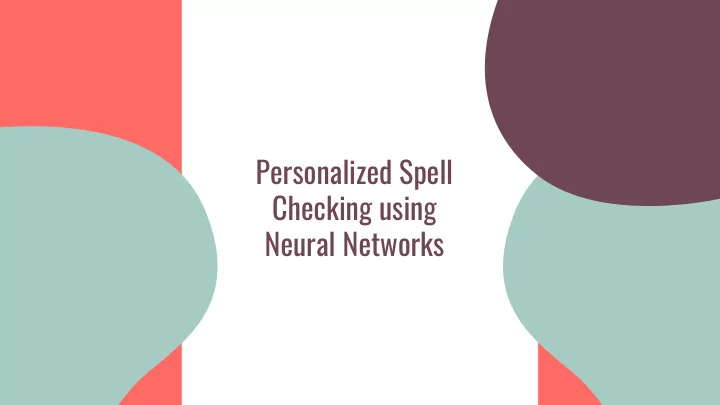

Personalized Spell Checking using Neural Networks
Amir Shokri Amirsh.nll@gmail.com
Most text editors let users check if their text contains spelling mistakes. Neural networks are now incorporated into many spell-checking tools. In Personalized Spell Checking using Neural Networks a new system for detecting misspelled words was proposed. This system is trained on observations of the specific corrections that a typist makes. It outwits many of the shortcomings that traditional spell-checking methods have.
Introduction
• spell check Introduction • feed-forward neural network typist ’ s behavior • many blogging and social networking sites • have included native support for spell checking (Web 2.0)
• misspelled words Introduction • dictionary of the spell checker • hashing techniques
• inter-language problems Introduction • context-sensitive problems (e.g. there instead of their) • dictionary size problems (e.g. holt) • incorrectly flagging acronyms • names as misspelled
PENN System Overview
PENN System • PENN system (Personalized Error Overview correction using Neural Networks) behavior of the typist •
PENN System Overview
PENN System Overview
actual choice for the neural network 1. The network is able to associate an erroneous-word with a corrected- word (referred to as a correction-pair) with a consistent, minimal amount of training.
actual choice for the neural network 2. Previously learned correction-pairs are unaltered by the subsequent training of new correction-pairs that do not share the same erroneous word.
actual choice for the neural network 3. Correction-pairs with the same erroneous word can compete for activation based upon the number of times each correction has been made
Evaluation of the PENN System
Evaluation of the • Initially, no words will be flagged as PENN System misspelled • Words that are misspelled and corrected enough times are characterized as possible errors in the system.
Evaluation of the • Different words that are misspelled in the same PENN System way will compete for the suggested position. Misspelled words need not even be words. • Acronyms for example can be flagged as possible errors if they are corrected enough times (e.g. USX to USA).
Evaluation of the • Misspellings can be words themselves (e.g. PENN System there to their). • Misspellings are specific to the person that made them.
If current method Replace raditional methods 1. Initially, the personalized method misses all misspelled words. This problem can be addressed by using the personalized method as a supplement to traditional spell checking methods.
If current method Replace raditional methods 2. Corrections made to misspellings that are also words (e.g. there to their) may introduce more false-negatives to flagging results. This could be handled by devising a system to include contextual information about the correction as additional input to the neural network, which would provide true context-sensitive flagging.
References 1. Golding, A. R. & Roth, D. (1999). A Winnow based approach to context-sensitive spelling correction. Machine Learning, 34(1-3), 107-130. 2. Damerau, F. J. (1964). A technique for Computer Detection and Correction of Spelling Errors. Communications of the Association for Computing Machinery, 7(3), 171-176. 3. Mays, E., Damerau, F. J., & Mercer, R. L. (1991). Context based spelling correction. Information Processing and Management, 27(5), 517-522. 4. Mangu, L. & Brill, E. (1997). Automatic rule acquisition for spelling correction. In Proceedings of the 14th International Conference on Machine Learning. Morgan Kaufmann.
THANKS! Hope You Enjoyed …
Recommend
More recommend